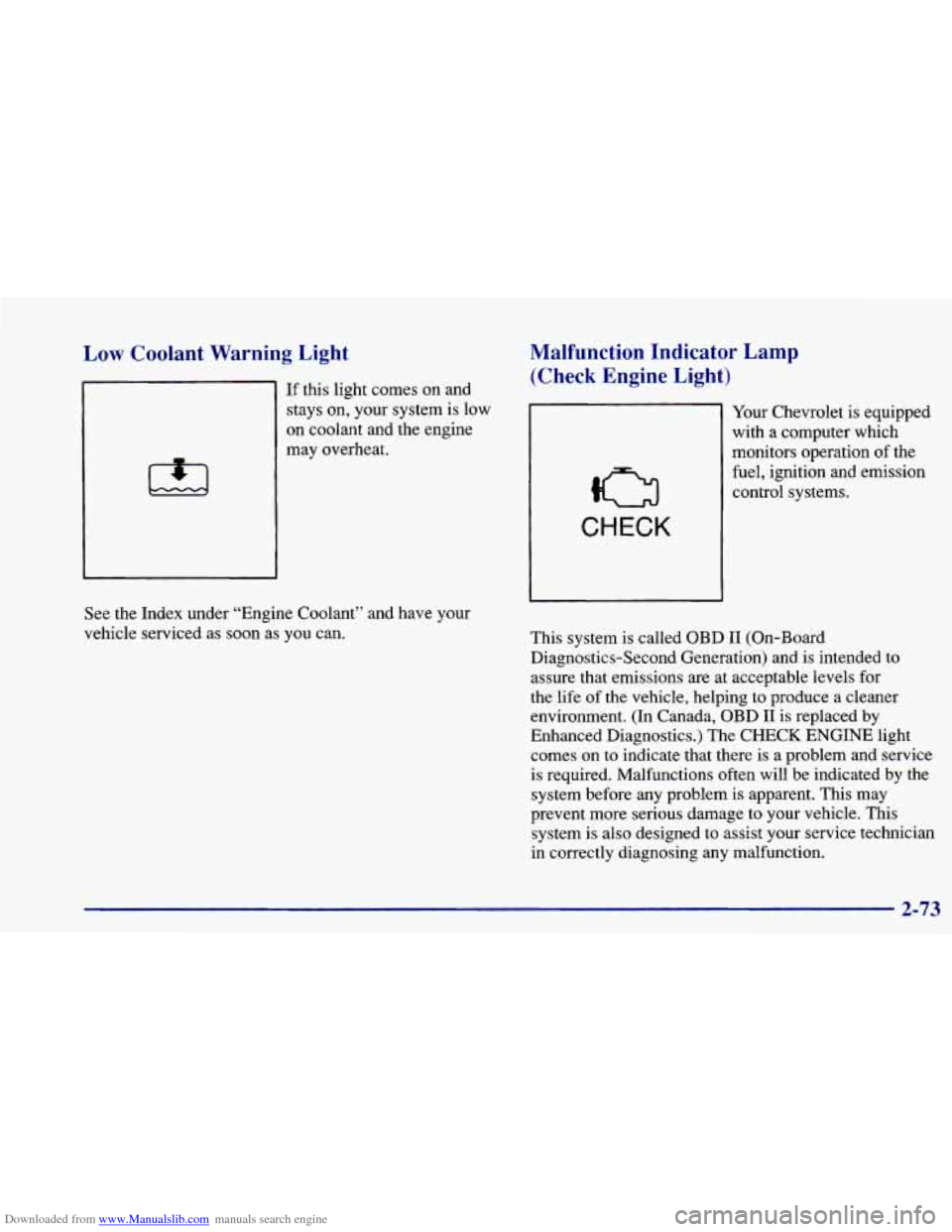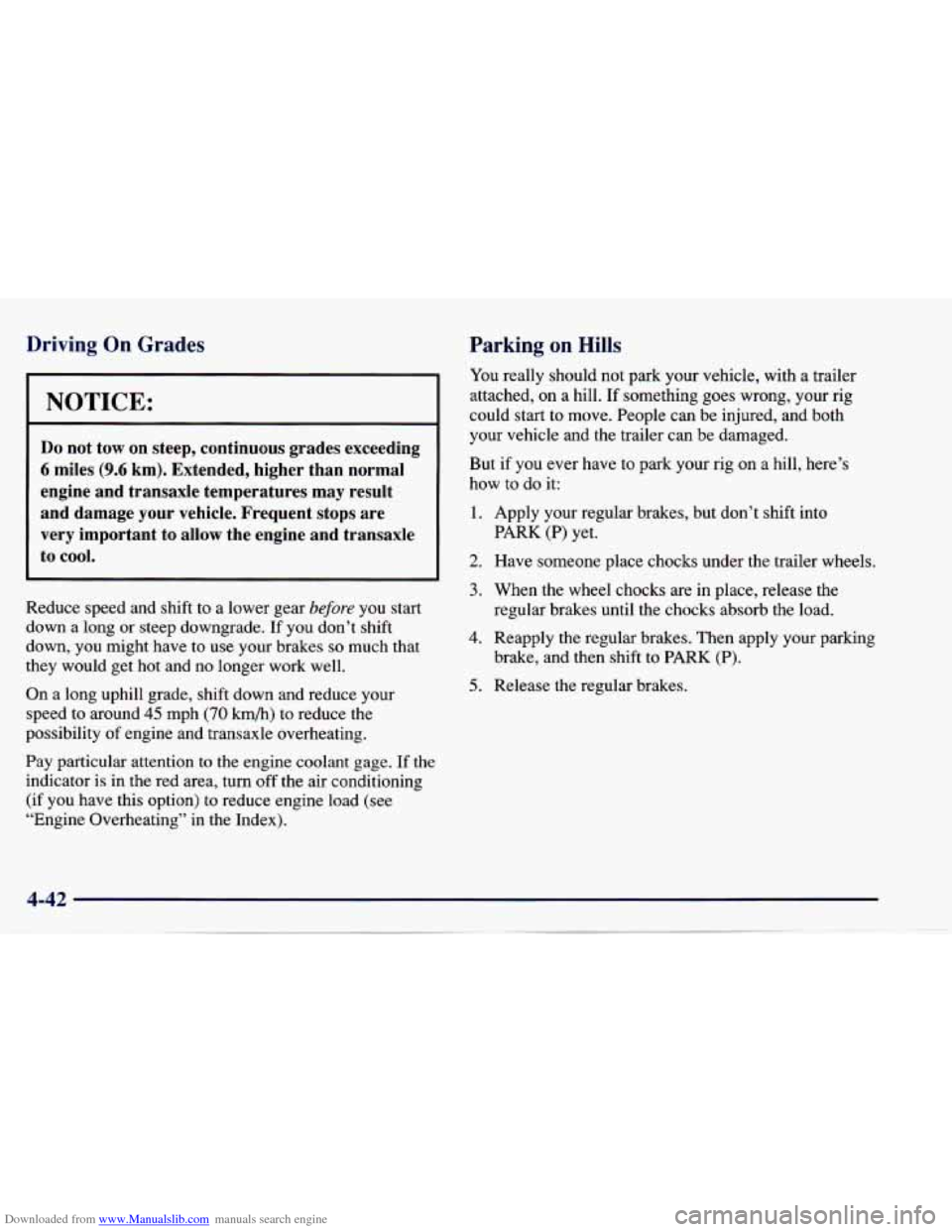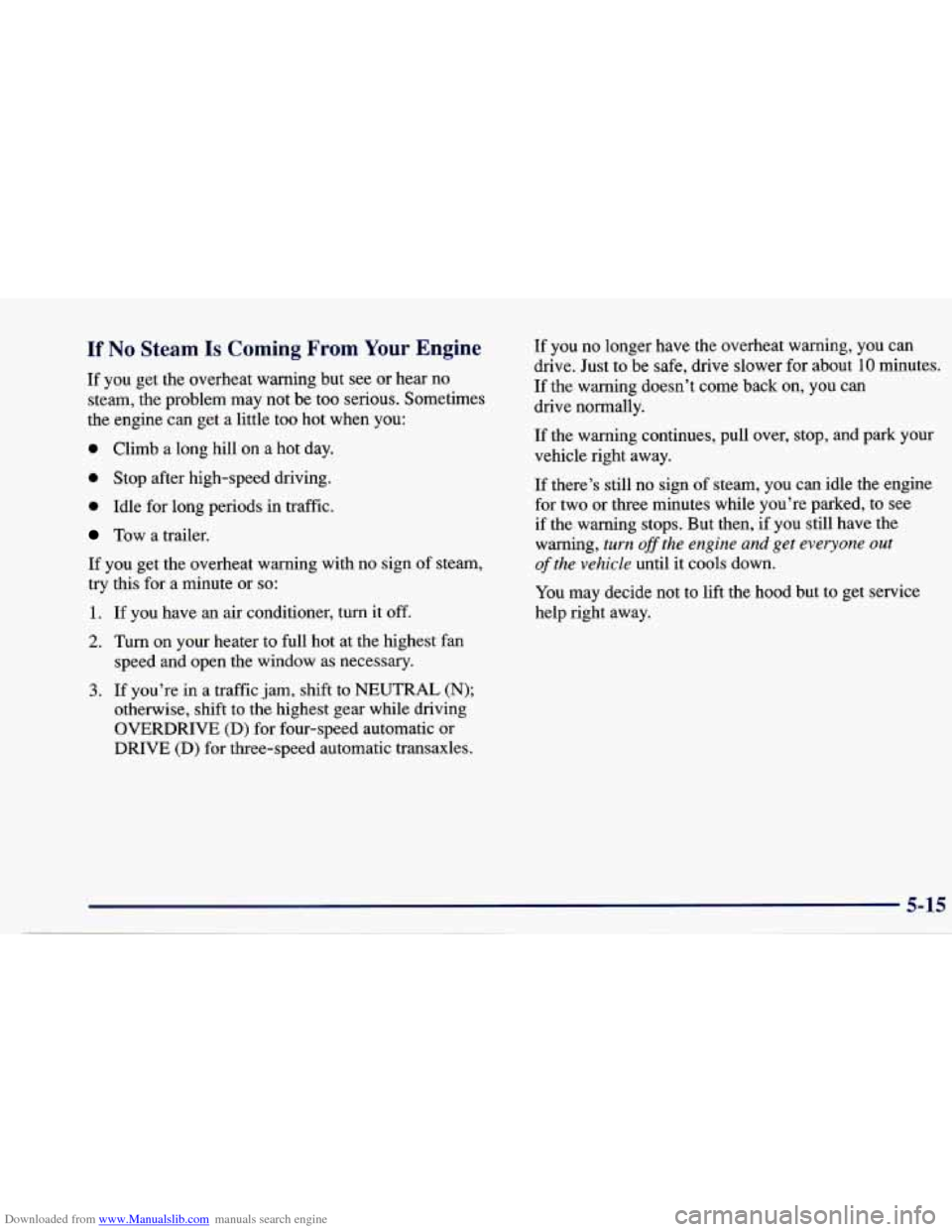Page 131 of 388

Downloaded from www.Manualslib.com manuals search engine Low Coolant Warning Light
If this light comes on and
stays on, your system is low
on coolant and the engine
may overheat.
Malfunction Indicator Lamp
(Check Engine Light)
CHECK
Your Chevrolet is equipped
with a computer which
monitors operation of the
fuel, ignition
and emission
control systems.
See the Index under “Engine Coolant’’ and have your
vehicle serviced as soon as
you can.
This system is called OBD I1 (On-Board
Diagnostics-Second Generation) and is intended to
assure that emissions are at acceptable levels for
the life of
the vehicle, helping to produce a cleaner
environment. (In Canada,
OBD I1 is replaced by
Enhanced Diagnostics.) The CHECK ENGINE light
comes on to indicate that there
is a problem and service
is required, Malfunctions often will be indicated by the
system before any problem is apparent. This may
prevent more serious damage to your vehicle. This
system is also designed to assist your service technician
in correctly diagnosing any malfunction.
2-73
Page 204 of 388

Downloaded from www.Manualslib.com manuals search engine Driving On Grades
NOTICE:
Do not tow on steep, continuous grades exceeding
6 miles (9.6 km). Extended, higher than normal
engine and transaxle temperatures may result
and damage your vehicle. Frequent stops are very important to allow the engine and transaxle
to
cool.
Reduce speed and shift to a lower gear before you start
down a long or steep downgrade. If you don’t shift
down, you might have to use your brakes
so much that
they would get hot and no longer work well.
On a long uphill grade, shift down and reduce your
speed to around
45 mph (70 km/h) to reduce the
possibility of engine and transaxle overheating.
Pay particular attention
to the engine coolant gage. If the
indicator is in the red area, turn off the air conditioning
(if you have this option)
to reduce engine load (see
“Engine Overheating” in the Index).
Parking on Hills
You really should not park your vehicle, with a trailer
attached,
on a hill. If something goes wrong, your rig
could start to move. People can be injured, and both
your vehicle
and the trailer can be damaged.
But
if you ever have to park your rig on a hill, here’s
how
to do it:
1.
2.
3.
4.
5.
Apply your regular brakes, but don’t shift into
PARK (P) yet.
Have someone place chocks under the trailer wheels.
When
the wheel chocks are in place, release the
regular brakes until the chocks absorb the load.
Reapply the regular brakes. Then apply your parking
brake, and then shift
to PARK (P).
Release the regular brakes.
Page 207 of 388
Downloaded from www.Manualslib.com manuals search engine 0 Section 5 Problems on the Road
Here you’ll find what to do about some problems that can occur on the road.
5-2
5-3
5-3
5-8
5-
14
Hazard Warning Flashers
Other Warning Devices
Jump Starting
Towing Your Vehicle
Engine Overheating 5-22
5-23
5-34
5-35
If a Tire Goes Flat
Changing a Flat Tire
Compact Spare Tire
If You’re
Stuck: In Sand, Mud, Ice or Snow
Page 220 of 388
Downloaded from www.Manualslib.com manuals search engine Engine Overh - -rting
YOU will find a coolant temperature gage and a low coolant
warning light on your Chevrolet’s instrument panel.
If Steam Is Coming From Your Engine
Steam from an overheated engine can burn you
badly, even
if you just open the hood. Stay away
from the engine if you see or hear steam coming
from it, Just turn it
off and get everyone away
from the vehicle until it cools down. Wait until
there is no sign of steam or coolant before you
open the hood.
If you keep driving when your engine is
overheated, the liquids in it can catch fire. You or
others could be
badly burned. Stop your engine if
it overheats, and get out of the vehicle until the
engine
is cool.
I NOTICE:
If your engine catches fire because you keep
driving with no coolant, your vehicle can be
badly damaged. The costly repairs would not be
covered
by your warranty.
Page 221 of 388

Downloaded from www.Manualslib.com manuals search engine If No Steam Is Coming From Your Engine
If you get the overheat warning but see or hear no
steam, the problem may not be too serious. Sometimes
the engine
can get a little too hot when you:
0 Climb a long hill on a hot day.
0 Stop after high-speed driving.
e Idle for long periods in traffic.
Tow a trailer.
If you get the overheat warning with no sign of steam,
try this for a minute or
so:
1. If you have an air conditioner, turn it off.
2. Turn on your heater to full hot at the highest fan
speed and open the window as necessary.
3. If you’re in a traffic jam, shift to NEUTRAL (N);
otherwise, shift to the highest gear while driving
OVERDRIVE
(D) for four-speed automatic or
DRIVE
(D) for three-speed automatic transaxles. If
you no
longer have the overheat warning, you can
drive. Just to be safe, drive slower for about
10 minutes.
If the warning doesn’t
come back on, you can
drive normally.
If the warning continues, pull over, stop,
and park your
vehicle right away.
If there’s still no sign of steam, you can idle the engine
for two or
three minutes while you’re parked, to see
if the warning stops. But then, if you still have the
warning,
turn off the engine and get everyone out
of the vehicle until it cools down.
You may decide not to lift the hood but to get service
help right away.
Page 223 of 388
Downloaded from www.Manualslib.com manuals search engine If the coolant inside the coolant surge tank is boiling,
don’t
do anything else until it cools down.
The coolant level should be at the
FULL COLD line.
If it isn’t, you may have a leak in the radiator hoses,
heater hoses, radiator, water
pump or somewhere else in
the cooling system.
A CAUTION:
Heater and radiator hoses, and other engine
parts, can be very hot. Don’t touch them. If you
do, you can be burned,
Don’t run the engine if there
is a leak. If you run
the engine, it could lose all coolant, That could
cause an engine fire, and you could be burned.
Get any leak fixed before you drive the vehicle.
NOTICE:
Engine damage from running your engine
without coolant isn’t covered
by your warranty.
If there seems to
be no leak, with the engine on, check to
see if the electric engine fan is running.
If the engine is
overheating, the fan should be running.
If it isn’t, your
vehicle needs service.
5-1
. .
Page 225 of 388
Downloaded from www.Manualslib.com manuals search engine A CAUTION:
Adding only plain water to your cooling system
can be dangerous. Plain water, or some other
liquid like alcohol, can boil before the proper
coolant mix
will. Your vehicle’s coolant warning
system is set for the proper coolant mix. With
plain water
or the wrong mix, your engine could
get too hot but you wouldn’t get the overheat
warning, Your engine could catch fire and you or
others could be burned. Use a
50/50 mix of clean
water and DEX-COOL@coolant.
NOTICE:
In cold weather, water can freeze and crack the
engine, radiator, heater core and other parts.
So
use the recommended coolant.
A CAUTION:
You can be burned if you spill coolant on hot
engine parts. Coolant contains ethylene glycol
and
it will burn if the engine parts are hot
enough. Don’t spill coolant on a hot engine.
Page 241 of 388

Downloaded from www.Manualslib.com manuals search engine If You’re Stuck: In Sand, Mud,
Ice or Snow
What you don’t want to do when your vehicle is stuck is
to spin your wheels too fast. The method known as
“rocking” can help you get
out when you’re stuck, but
you must use caution.
If you let your tires spin at high speed, they can
explode, and you or others could be injured.
And, the transaxle or other parts of the vehicle
can overheat. That could cause an engine
compartment fire or other damage. When you’re
stuck, spin the wheels
as little as possible. Don’t
spin the wheels above
35 mph (55 km/h) as shown
on the speedometer.
I NOTICE:
Spinning your wheels can destroy parts of your
vehicle as well as the tires.
If you spin the wheels
too fast while shifting your transaxle back and
forth, you can destroy your transaxle.
For information about using tire chains on your vehicle,
see “Tire Chains” in the Index.
Rocking Your Vehicle To Get It Out
First, turn your steering wheel left and right. That will
clear the area around your front wheels. Then shift back
and forth between REVERSE
(R) and a forward gear
(or with a manual transaxle, between FIRST
(1) or
SECOND
(2) and REVERSE (R)), spinning the wheels
as little as possible.
(If your vehicle has the Enhanced
Traction System, shift back and forth between
REVERSE (R) and FIRST
(1) or SECOND (2),
spinning the wheels as little as possible.) Release the
accelerator pedal while you shift, and press lightly on
the accelerator pedal when the transaxle is in gear. If
that doesn’t get you out after a few tries, you may need
to be towed out. If you do need to be towed out, see
“Towing Your Vehicle” in
the Index.
5-35